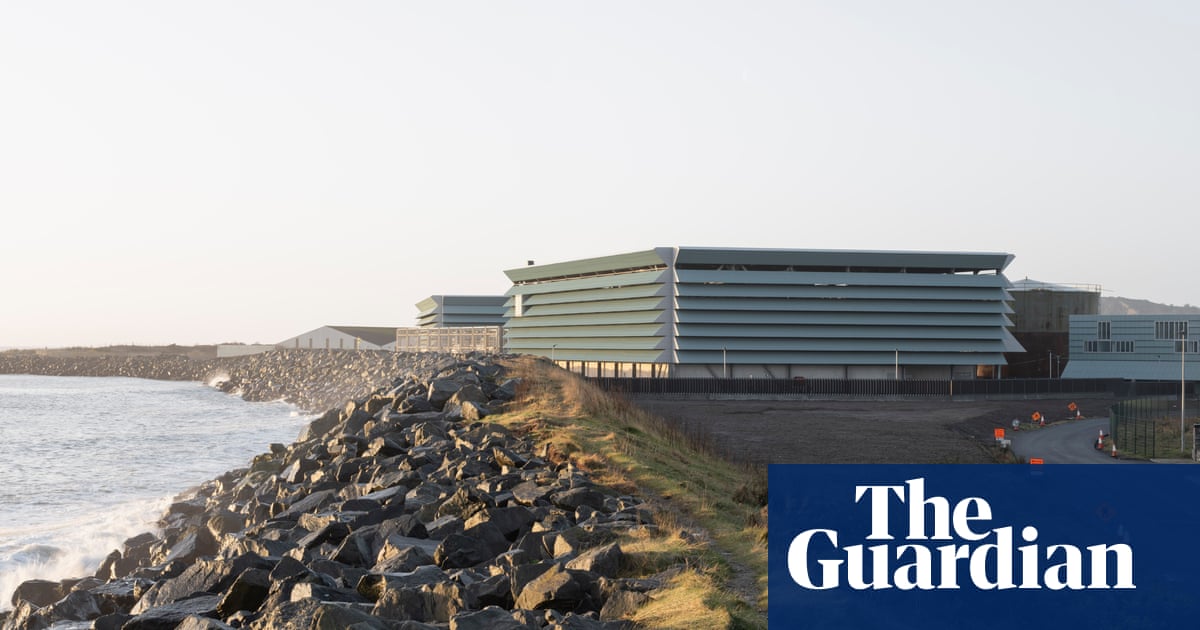Photo credit: www.theguardian.com
Transforming Wastewater Treatment: Arklow’s Innovative Approach
It may seem unusual for an arts section to discuss the aesthetic qualities of a wastewater treatment plant, but the newly constructed €139 million (€117 million) facility in Arklow, Ireland, stands as an architectural marvel on the country’s southeast coast. Designed by Clancy Moore Architects, this treatment plant presents a striking image, resembling modernist pagodas in a minty green hue against the backdrop of the Irish Sea.
Andrew Clancy, co-founder of the architectural firm, draws an interesting connection to James Joyce’s *Ulysses*, highlighting the beauty and complexity inherent in water management systems. As he traverses a metal gantry overlooking extensive waste processing tanks, Clancy reflects on Joyce’s narrative of the water cycle, remarking on how such vital aspects of urban infrastructure frequently go unnoticed.
This sentiment resonates in Arklow, a town that has long grappled with wastewater management issues. For generations, the 13,500 residents have had no treatment plant, discharging waste directly into the Avoca River and then the sea. The European Union has taken notice, with the European Court of Justice repeatedly ruling against Ireland for failing to comply with wastewater management directives, resulting in significant fines and stunted local development efforts.
A plan to construct a sewage treatment plant dates back to 1988 but was fraught with controversy and prolonged planning disputes. Initial proposals were met with opposition from local residents concerned about environmental impacts and site safety. After a protracted struggle, Irish Water, the state-owned utility, resumed efforts with a renewed focus on community engagement. They selected a site on the former location of a wallboard factory in Ferrybank, choosing a low point that minimized pumping requirements. The national planning board emphasized the necessity of architectural involvement due to the site’s visibility, setting the stage for an iconic infrastructure project that would enhance, rather than detract from, the landscape.
Clancy likens the significance of a wastewater facility to well-known cultural landmarks, arguing that practical infrastructure deserves the same level of design consideration. The Arklow facility ultimately serves as a reinvention of civic architecture, celebrating the critical nature of wastewater treatment with a design that aspires to elegance instead of anonymity.
The plant’s design is both functional and aesthetically pleasing, featuring large processing sheds that dominate the skyline with serrated profiles and expansive louvres. These architectural choices not only give a nod to nautical themes familiar to Arklow, a town with a rich maritime heritage, but they also serve as habitats for local wildlife, including bats and birds.
Upon closer inspection, the architectural details of the treatment plant reveal a playful yet serious approach to form and scale, with careful choices that elevate its industrial context. The lab building, with its whimsical facade and inviting features, adds a touch of character. Each structure carries thoughtful elements that reflect the site’s purpose while remaining approachable and engaging.
In contrast to standard practices, where design considerations often take a backseat, Clancy Moore Architects insisted on prioritizing the architecture. This decision resulted in a contract designed to protect their vision throughout the construction process. The architectural elements represent only about 3% of the overall budget, yet they have transformed a necessary facility into a community landmark.
The incorporation of various innovations at the treatment plant marks a significant leap forward. Instead of relying on conventional pumping methods, Arklow’s system uses gravity to facilitate the majority of its processes, thus enhancing energy efficiency. Additionally, the plant includes a solar farm designed to fulfill a considerable portion of its energy needs.
For the residents of Arklow, the completion of this wastewater treatment plant represents a significant milestone. As project manager Michael Tinsley succinctly summarizes, no community wants to be burdened with environmental failures. This transformation highlights a broader discussion about how essential infrastructure can be designed not only for utility but also for beauty, creating a blueprint for sustainability and architectural integrity that might inspire similar projects elsewhere.
In comparison, the British water infrastructure narrative reveals stark contrasts. The privatization of England’s water industry has led to deteriorating conditions, with escalating incidents of raw waste discharged into rivers. Observing Ireland’s nationalized approach highlights a potential pathway toward addressing these issues while fostering an aesthetically and environmentally conscious future.
Source
www.theguardian.com

